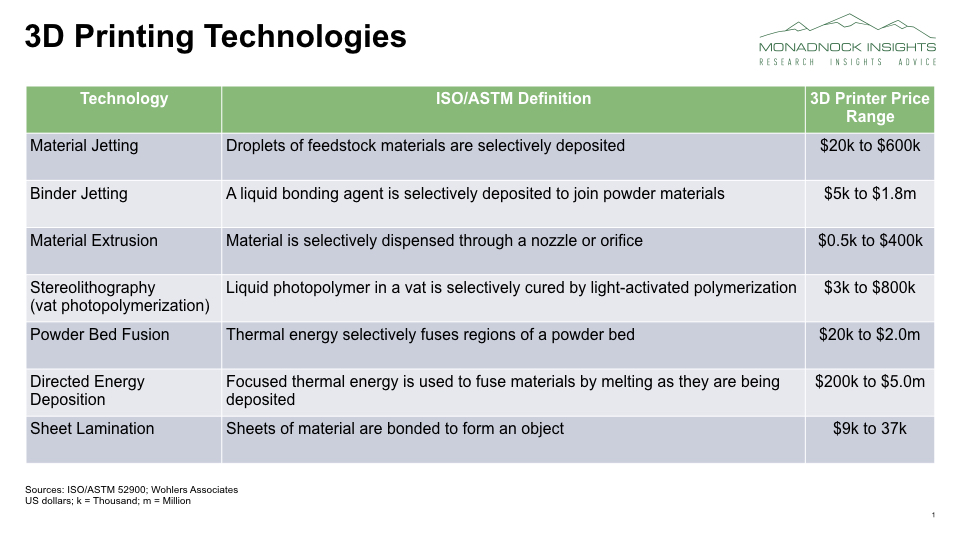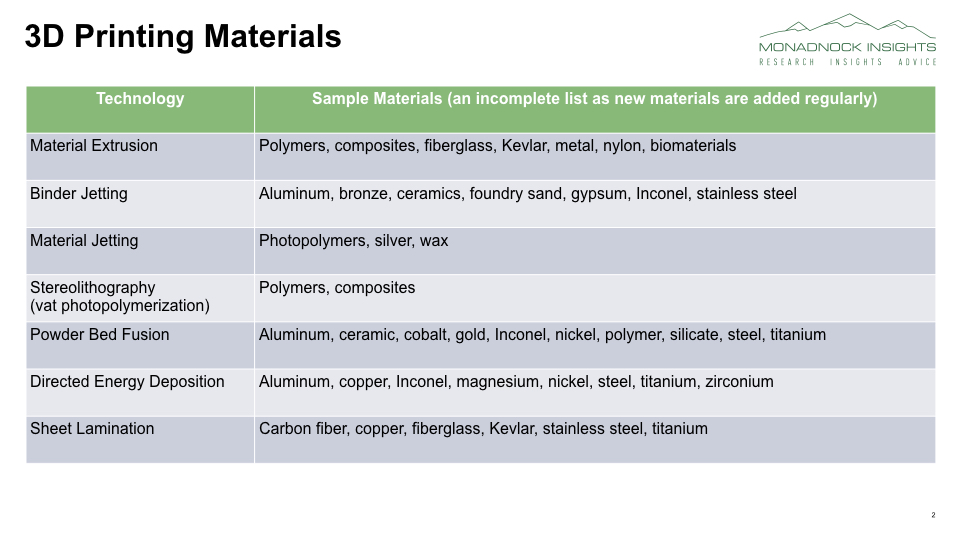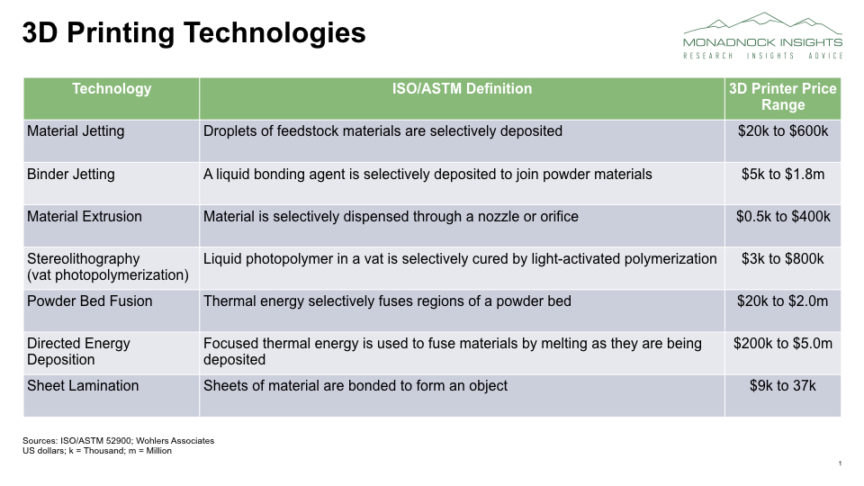What comes to mind when you think of inkjet printing? Do you think of substrates (papers, textiles, electronics)? Do you think of two dimensional applications (direct mail, books, ceramics)? Or do you think in three dimensions (displays, jet engines, medical implants)?
Inkjet printing is one in a long line of variable imaging technologies going back 1,000 years. Really: Bi Sheng invented movable type around 1040. The intervening centuries brought numerous ways to print in two dimensions: dye sublimation, electrophotography, flexography, gravure, inkjet, intaglio, offset, screen and more. Today, jetting technology has the most upside growth and application potential of all the printing technologies, with uses ranging from 2D printing to bioprinting to 3D printing.
3D printing is not one technology, no more than 2D printing is one technology. And two of the seven 3D printing technologies are variations on the inkjet technology you are familiar with, often using jetting technology provided by inkjet vendors you know well.
Why is the intersection of inkjet and 3D printing important to your business? Will there be a new market opportunity? Possibly. Will 3D printed replacement parts enable you to meet critical deadlines? Definitely. Will 3D printed modifications improve your equipment and assembly operations? Very likely. Will the research and development that advances 3D printing improve the range and performance of inkjet presses? Absolutely.
To understand the intersection of inkjet and 3D printing it is best to understand what 3D printing is. Many people still think all 3D-printed parts are single color plastic bits. Nothing could be further from reality.
3D Printing Defined
3D printing is the additive process of joining materials to create objects based on digital models. The joining typically occurs layer by layer, with one layer added on top of another in a continuous process. Many engineers and other people say that “additive manufacturing” is a more accurate term but laypeople and the general media know the process as “3D printing.”
3D printing begins with a digital model, typically created using computer-aided design (CAD) software but may involve other sources such as CT scans. The resulting file is sent to the 3D printer and modified for printing, much like what happens within the raster image processer (RIP) used by a 2D printer. The process of physically joining materials and colors employs one of the seven technologies and a growing range of 3D-printable materials.
The finished objects range from prototypes to production aids to finished goods. The design of 3D printed objects is almost limitless, constrained as much by the designer’s imagination as by the physical limits of the chosen 3D printer, much like 2D printing. And just as most 2D printed products require some kind of binding, assembly, stuffing or other finishing process, most 3D printed objects require some form of post-processing prior to their use.
3D Printing Technologies
The international standards body ISO/ASTM defines the currently available technologies as shown below:

Material and binder jetting are, as their names imply, based on jetting technology, just like your personal printer or production press. Material jetting emits plastics (or cellular materials) to build the part. Binder printers jet a fluid that literally binds powders ranging from plastic to foundry sand.
Mimaki, well-known for its flatbed printers, offers the 3DUJ-553 binder jetting 3D printer that is capable of printing 10 million colors. The device, which is the 2019 SGIA 3D printer Product of the Year, can achieve 90% of SWOP colors. The resulting color accuracy and relatively smooth surface minimizes finishing times. A potential market for printing companies that produce display signage is the production of color 3D printed items that either attach to or complement the 2D printed displays.
Material extrusion and stereolithography are the two original 3D printing technologies, invented more than 30 years ago. As you can see from the price range, material extrusion is used in consumer and industrial 3D printing. The idea of consumers making things with material extrusion 3D printers was at the core of the hype around 3D printing a decade ago. While some hobbyists may use stereolithography, for the most part the low-priced devices are used in an office environment where prototypes are made.
Material extrusion provides new market opportunities for traditional printing companies. MASSIVit has clients who are using its printers to produce displays for events, point-of-sale advertising fixtures and amusement park figures. For example, the wide format printing company Colorzenith 3D printed giant dimensional billboards promoting Armani’s latest fashion and accessories collection, following the success of a previous billboard campaign that used 3D printing as well.
When people think of 3D printing metal, they often picture powder bed fusion printers. These devices generally use either lasers or electron beams as the energy source to fuse the raw powder material into a 3D object. But do not assume that powder bed fusion is only for metal printing – polymers are also used (although not in the same machine that 3D prints metal).
HP employs jetting technology and a unique fusing process in its 3D printers. HP’s Multi Jet Fusion technology is built on its R&D in inkjet printing, material science and imaging. By jetting HP functional agents using HP printheads, material in the build area is rapidly fused, detailed, and transformed one 3D pixel (called a voxel) at a time. In a case of using 3D printers to manufacture 3D printers, HP uses more than 140 3D-printed nylon parts in its Jet Fusion 500/300 Series devices.
On the other hand, directed energy deposition (DED) can only print metals, generally using a stream of powder that is lazed at the point where the layer is being built. A unique characteristic of DED is its ability to be used as a selectable tool within a CNC machine, enabling both additive printing and subtractive processes such as machining, drilling and polishing all in one operation. DED can be used to repair metal parts and reduce maintenance costs by, for example, adding material onto a worn part such as components of a high-speed web press, bindery system or direct mail inserting line.
Sheet lamination at one point included not only the ultrasonic welding of exotic metals and non-wovens but also (in a radically different process), laminating basic office paper. However, Mcor Technologies has gone into receivership, putting the future of its paper 3D printing process in doubt. Other vendors continue their development work on metals and non-woven materials.
Bear in mind that while there are seven technologies currently acknowledged by ISO/ASTM, many if not most 3D printer technology providers say they have unique technologies. Those claims would have to be validated on a case-by-case basis but, fundamentally, commercially available 3D printers have the seven technologies at their core.
3D Printing Materials
The number of 3D-printable materials is a small fraction of all of the plastics, composites, alloys and metals used worldwide. Nevertheless, 3D printers use a wide – and growing – range of common, precious and exotic materials:

Certainly polymers, composites, carbon fiber and other materials can benefit your operation. Your company may not have a market for 3D printed products (yet) but will always have a need to repair broken parts, even if a short-term fix while waiting for an OEM part. You may have assembly operations that require custom jigs and fixtures for your finishing personnel to use. You may have creative operations and maintenance personnel who can use 3D printed parts to modify commercial-off-the-shelf equipment in order to produce new and better inkjet-printed products.
As you think about the intersection of inkjet and 3D printing, talk with us about how the different 3D printing technologies, price points, materials, capabilities and uses will benefit your business.


Comments
Pete, Great Article. Glad I found it. I am in a manufacturing environment where we supply the RV industry with all sorts of fiberglass and polyurethane products (think simulated wood trim, light bezels, backsplashes, shower walls). We currently have a SUN3D printer and we need to be looking at purchasing a 2nd 3D printer – however, I am having difficulty finding other companies that manufacture large format UV cured inkjet / 3D printers. Do you have any suggestions? Thanks for any info or direction you can point me.